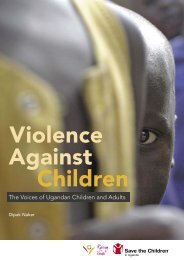Download PDF - Raising Voices
Download PDF - Raising Voices
Download PDF - Raising Voices
Create successful ePaper yourself
Turn your PDF publications into a flip-book with our unique Google optimized e-Paper software.
Creating Safer Schools: Lessons Learned; Strategies for Action Session 1IntroductionEducation has been declared a priorityissue in key internationally agreed policydocuments. Every major meeting addressinginternational development has had pertinentcomment to make on the importance ofeducation. Article 28 of the Convention onthe Rights of the Child (CRC) specificallyaddresses every child’s right to education.The second millennium goal promises accessto primary education to all the children ofthe world by 2015. Many African countrieshave already instituted credible programsto respond to this challenge, includingimplementation of a time-bound, universalaccess to primary education policy. Manycountries, such as Uganda and Tanzania,declare themselves ahead of the agreedtimetable and some are now even pressingon with the aim of creating universal accessto secondary education. Clearly, these areimportant achievements.However, while we may appear to besucceeding in a narrow interpretation of thegoal – that of enabling children’s physicalpresence in schools – in a more meaningfulsense, we have more work to do. A clearconsensus is emerging around the view thatsimply reporting higher enrolment numbersis not enough. The quality of the educationand children’s experience during the processof education is a better measure of thesystem’s success. 1 The Dakar Framework forAction (2000) has established six, Educationfor All (EFA) goals, two of which specificallyaddress the importance of quality education.Many policy and advocacy initiatives aroundthe world emphasize the importance of aquality education in expanding children’spossibilities.Article 28 of the Conventionon the Rights of the Child(CRC) specifically addressesevery child’s right to education.The second millennium goalpromises access to primaryeducation to all the children ofthe world by 2015.They experience ad hoc beating, degradingpunishments, sexual violence, bullying, andhumiliation routinely in our schools. In arecent survey commissioned by UNICEF in 11Sub-Saharan African countries, 7 out of the11 countries listed violence in schools as oneof the top three priorities to be addressed 2 . Ina study conducted in Uganda 3 , more than 60percent of the students said they experiencedviolence regularly in schools.If a school is envisioned as a place thatequips children with the primary buildingblocks that will enrich their lives, and a placethat enables students to become vibrant andresponsible members of a democracy aswell as the economy, then a vast number ofstudents are being denied that opportunity.If a school is seen as a place to enrichcognitive and emotional development ratherthan a place for generating compliant andintimidated individuals, then we need urgentresponses that address the status quo.1 A recent study conducted by the independent evaluation groupof the World Bank concluded that enrolment and number of yearsof schooling is not enough to conclude success. Learning outcomesbased on a broader measure of children’s development were moreimportant.See www.worldbank.org/oed/education/findings/htmlA central concern regarding the quality ofeducation is the issue of safety at school.There is considerable evidence to suggestthat schools are not benign ‘waiting rooms’within which children await adulthood.2 Assessment of Violence Against Children in the Eastern and SouthernAfrica Region. F. Zuberi, UNICEF ESARO, (2005) downloadable fromwww.crin.org/docs/ESA_Regional_Assessment_final.doc3 Violence Against Children. The <strong>Voices</strong> of Ugandan Childrenand Adults. D. Naker, <strong>Raising</strong> <strong>Voices</strong>, downloadable fromwww.raisingvoices.org/children/violence_research.php
















